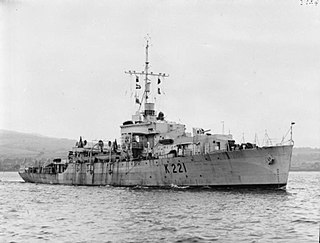
HMS Loch Insh was a Loch-class frigate of the Royal Navy, named after Loch Insh in Scotland. She was built by Henry Robb of Leith and launched on 10 May 1944. After service at the end of World War II she was decommissioned, but reactivated in 1950 and served, mostly in the Persian Gulf, until 1962. The ship was sold to the Royal Malaysian Navy in 1963 and renamed KD Hang Tuah (F433). She was scrapped in 1977.

HMS Loch Killin was a Loch-class frigate of the Royal Navy, named after Loch Killin in Scotland. The ship was laid down at Burntisland Shipbuilding Company's yard in Fife on 2 June 1943, and launched on 29 November 1943. She was one of the first vessels armed with the brand new Squid anti-submarine mortar. Decommissioned in September 1945, the ship was put into Reserve, and finally scrapped on 24 August 1960.

The Flower-class corvette was a British class of 294 corvettes used during World War II by the Allied navies particularly as anti-submarine convoy escorts in the Battle of the Atlantic. Royal Navy ships of this class were named after flowers.

HMS Peony was a Flower-class corvette of the Royal Navy. In 1943 she was transferred to the Royal Hellenic Navy as RHNS Sachtouris, serving throughout World War II and the Greek Civil War. She was returned to the Royal Navy in 1951 and scrapped in April 1952.

HMS Nene was a River-class frigate, designed for anti-submarine operations, that served with the Royal Navy during the Second World War. In 1944 she was loaned to the Royal Canadian Navy and recommissioned as HMCS Nene, who returned her to the Royal Navy in 1945. Following the war she remained in reserve until disposed of in 1955.
HMS Goodall (K479) was a British Captain-class frigate of the Royal Navy in commission during World War II. Originally constructed as the United States Navy Evarts-class destroyer escort USS Reybold (DE-275), she served in the Royal Navy from 1943 until her sinking in 1945.
HMS Gould (K476) was a British Captain-class frigate of the Royal Navy in commission during World War II. Originally constructed as the United States Navy Evarts-class destroyer escort USS Lovering (DE-272), she served in the Royal Navy from 1943 until her sinking in 1944.
HMS Veronica was a Flower-class corvette, built for the Royal Navy during the Second World War, and was in service in the Battle of the Atlantic. In 1942 she was transferred to the United States Navy as part of the reverse Lend Lease arrangement and renamed USS Temptress, the name ship of the Temptress-class gunboats. With the end of hostilities she was returned to the Royal Navy and sold into mercantile service.

HMS Alisma was a Flower-class corvette that served in the Royal Navy.

HMS Dart (K21) was a River-class frigate of the Royal Navy. Dart was built to the RN's specifications as a Group I River-class frigate.

HMS Dianella was a Flower-class corvette of the Royal Navy. She served during the Second World War.
HMS Itchen (K227) was a River-class frigate of the Royal Navy (RN). Itchen was built to the RN's specifications as a Group I River-class frigate. She served in the North Atlantic during World War II.

HMS Teviot (K222) was a River-class frigate of the Royal Navy (RN) from 1942–1955. She served in convoy defence duties in the North Atlantic and Eastern Fleet during World War II. After the war, she served in the South African Navy as HMSAS Teviot before returning to Royal Navy service after six months. Teviot was built to the RN's specifications as a Group I River-class frigate.

HMS Chelmer (K221) was a River-class frigate of the Royal Navy (RN) from 1943 to 1957. She served in convoy defence duties in the North Atlantic during World War II. Chelmer was built to the RN's specifications as a Group I River-class frigate, although Chelmer was one of the few powered by a turbine engine.

HMS Cam (K264) was a River-class frigate of the Royal Navy (RN) from 1944–1945. She served in convoy defence duties in the North Atlantic during World War II. Cam was built to the RN's specifications as a Group II River-class frigate, though Cam was one of the few powered by a turbine engine.
HMS Cuckmere (K299) was a River-class frigate of the Royal Navy (RN) in 1943. Cuckmere was originally to be built for the United States Navy, having been laid down as PG-104, but was transferred to the Royal Navy as part of Lend-Lease and finished to the RN's specifications as a Group II River-class frigate. She was first Royal Navy ship to carry the name Cuckmere.

HMS Mourne (K261) was a River-class frigate of the Royal Navy (RN). Mourne was built to the RN's specifications as a Group II River-class frigate. She served in the North Atlantic during World War II.
HMS Tweed (K250) was a River-class frigate of the Royal Navy (RN). Tweed was built to the RN's specifications as a Group I River-class frigate, though Tweed was one of the few powered by a turbine engine. She served in the North Atlantic during World War II.
HMS Aire, later renamed Tamar, was a River-class frigate of the Royal Navy (RN). Aire was built to the RN's specifications as a Group II River-class frigate. She served in the North Atlantic during World War II.

HMS Larkspur was a Flower-class corvette, built for the Royal Navy during the Second World War, and was in service in the Battle of the Atlantic. In 1942 she was transferred to the United States Navy as part of the Reverse Lend-Lease arrangement and renamed USS Fury, one of the Temptress-class gunboats. With the end of hostilities she was returned to the Royal Navy and sold into mercantile service.













